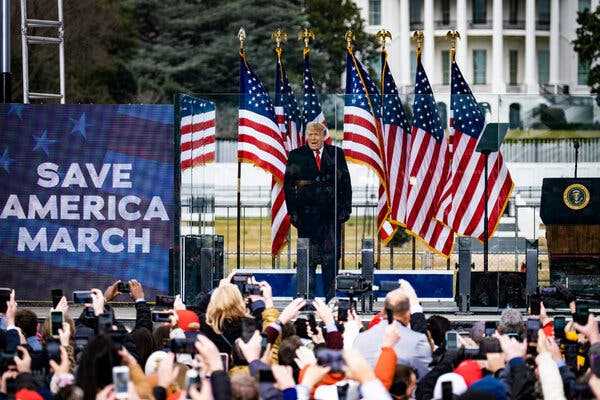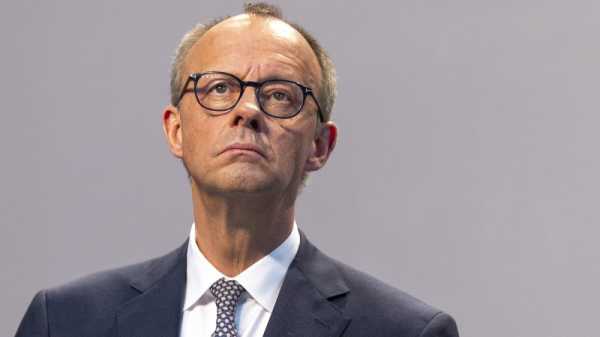The Justice Department is under no obligation to adopt the House committee’s recommendations, and not much is publicly known about any specific charges that the special counsel, Jack Smith, might consider.
-
Send any friend a story
As a subscriber, you have “>10 gift articles to give each month. Anyone can read what you share.
Give this articleGive this articleGive this article

President Donald J. Trump addressing a crowd of his supporters on the Ellipse on Jan. 6, 2021, not long before a pro-Trump mob attacked the Capitol.
The House select committee laid out an ambitious road map for the prosecution of former President Donald J. Trump and several of his allies on Monday, saying they had committed a number of federal crimes by undertaking overlapping plans to reverse the results of the 2020 election.
But it remains unclear just how closely the special counsel’s office in charge of the Justice Department’s own investigation will follow the path mapped out by the committee — or whether Mr. Trump and others will face any criminal charges at all.
The panel’s recommendations that charges should be brought were based on an exhaustive investigation that spanned months and included interviews with key witnesses that even federal prosecutors may not have spoken to yet.
Not much is publicly known about any specific charges that the special counsel, Jack Smith, might consider in any prosecution, and the Justice Department is under no obligation to adopt the committee’s conclusions or recommendations.
Understand the Events on Jan. 6
- Timeline: On Jan. 6, 2021, 64 days after Election Day 2020, a mob of supporters of President Donald J. Trump raided the Capitol. Here is a close look at how the attack unfolded.
- A Day of Rage: Using thousands of videos and police radio communications, a Times investigation reconstructed in detail what happened — and why.
- Lost Lives: A bipartisan Senate report found that at least seven people died in connection with the attack.
- Jan. 6 Attendees: To many of those who attended the Trump rally but never breached the Capitol, that date wasn’t a dark day for the nation. It was a new start.
Search warrants and subpoenas that have surfaced during the Justice Department’s investigation suggest that there is some — but certainly not perfect — overlap between criminal statutes cited by the department and the charges the committee recommended.
One charge that both the panel and prosecutors have placed at the center of their investigations of Mr. Trump is the obstruction of an official proceeding before Congress. The Justice Department mentioned that count in a warrant used in June to seize the cellphone of Jeffrey Clark, a former department official who the committee referred for criminal charges.
Prosecutors have already used the obstruction count in nearly 300 criminal cases to describe how the mob that stormed the Capitol on Jan. 6, 2021, disrupted the certification of the election that was taking place there during a joint session of Congress.
Still, the statute was never an easy fit for the violence that erupted at the Capitol.
It was passed into law as part of the 2002 Sarbanes-Oxley Act, which sought to curb corporate malfeasance by clamping down on things like shredding documents or tampering with witnesses. And defense lawyers have challenged its use in a federal appeals court in Washington, arguing that prosecutors stretched it beyond its original scope and used it to criminalize behavior that closely resembles protest protected by the First Amendment.
Still, the obstruction count could apply much better to Mr. Trump’s behavior than to that of hundreds of ordinary rioters.
The law requires proving that any interference with a congressional proceeding be done “corruptly.” The committee said in its recommendations that Mr. Trump clearly acted with a “‘corrupt’ purpose” because he was warned in advance that several of his schemes to maintain his grip on power were illegal.
The committee also recommended that Mr. Trump and others be charged with conspiracy to defraud the United States, a count that has been used in several Justice Department cases against both far-right extremists and ordinary rioters who appeared to have planned in advance to storm the Capitol.
Again, this conspiracy charge may in fact better describe the evidence against Mr. Trump, who, according to the committee, defrauded the public by making constant false claims that the election had been rigged against him.
The most serious charge the panel has recommended against Mr. Trump is also likely to be the hardest to prove: insurrection. While the Justice Department has won a conviction on a related charge, seditious conspiracy, against Stewart Rhodes, the leader of the Oath Keepers militia, and is set to try five members of another far-right group, the Proud Boys, for sedition, it has not charged anyone with insurrection in more than 900 criminal cases.
Still, a federal judge in Washington laid the ground for a potential insurrection case against Mr. Trump in a ruling in February that permitted a series of Jan. 6-related civil cases filed against the former president to move forward.
In his ruling, the judge, Amit P. Mehta, said Mr. Trump was not merely exercising his First Amendment right to free speech when he called on the crowd listening to him on Jan. 6 to march on the Capitol and “fight like hell.”
Judge Mehta also found that there was a reasonable case to be made that Mr. Trump had aided and abetted those in the mob who assaulted the police at the Capitol — in part, by waiting so long to call publicly for the rioters to calm down. One of the ways that prosecutors could prove that Mr. Trump engaged in insurrection is by showing that he gave “aid and comfort” to others who took part in a rebellion against the government.
Source: nytimes.com



